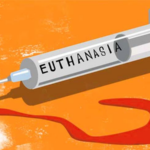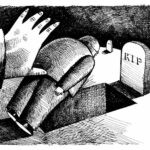By Jonathon Van Maren
In the first in-depth essay article on what killing in Canada is like—“How to End a Life”–Toronto Life Magazine has given us a fascinating and stomach-turning look into the world of medical practitioners trained to save lives but now tasked with ending them. Nicholas Hune-Brown, the author of the essay, clearly went to great lengths to understand the different sides of the issue and explore Canada’s emerging euthanasia regime.
The first thing Hune-Brown highlights is the confusion that spread throughout the medical community after Canada formally passed assisted suicide legislation. Madeline Li, an oncologist psychiatrist at Princess Margaret Hospital, took the lead on figuring out how to implement what the column glibly calls “medically assisted death.” Li is up front about the fact that the only reason she’s involved in the procedure is because it’s legal: “I came to MAID not because I’m a huge advocate for it or because I’m against it, but because it’s now a patient’s right,” she said. It reminded me of what Ontario late-term abortionist Dr. Fraser Fellows said at one of his debates: That as long as the procedure was legal, he’d perform it. Laws always end up informing morality.
Li dispenses with the pleasant fictions that organizations like Death With Dignity have been spreading with admirable bluntness:
Figuring out the best method for death was also complicated. In Oregon, where assisted death is legal, doctors can write patients a description for a lethal oral medication and then walk away. Canadian physicians were surprised to learn that the barbiturates used in that protocol weren’t available here. Instead, doctors and nurses deliver a series of drugs intravenously, a process that is far more intimate than writing a prescription. Assisted death, the polite euphemism used to describe the act, is really a misnomer. Doctors don’t “assist” in a death; they are the active agents. “We are doing euthanasia,” says Li. “We are actively ending a life. And it’s very new to us.”
Not only is it new, but the transition from healing to killing is often very difficult for those involved. Li mentions her shock at the moment she realized that it wasn’t necessary to sterilize the syringes used to dispatch the patients. The new “right” of patients to have someone kill them sent shockwaves right through the medical community:
…she realized that assisted death affected everyone in the building—the volunteers and the translators, the porters who transport the lethal drugs across floors, the housekeeping staff who could find themselves cleaning a room where [a] person had been killed.
One anonymous Toronto doctor realized very quickly that finding people willing to involve themselves in killing patients was more difficult than he’d thought. It took him a long time to find a pharmacy willing to prepare the lethal drugs he needed, and even when he found a pharmacy, he couldn’t find a nurse willing to insert the IV and was forced to do it himself. Most physicians don’t want to become euthanasia practitioners, either—there are only 105 doctors across Ontario willing to “perform assisted deaths.” As the Hune-Brown puts it:
While polls show that close to 80 percent of Canadians believe in the right to assisted death, most doctors remain against it. A Canadian Medical Association Survey from 2015 showed 63 percent of physicians were unwilling to perform the procedure. For them, the question isn’t whether patients should have the option to choose their death. It’s whether doctors should be compelled to kill them.
In one stroke, doctors have both been given the right to kill in some circumstances and—if suicide activists have their way—they will soon no longer have the right to refuse this new “right,” even though—or perhaps because—a majority of doctors are uncomfortable with performing the procedure. It is interesting and a bit heartening to know that a majority of physicians do not want to be involved in the taking of a human life—75% of the members of the Canadian Society of Palliative Care Physicians oppose assisted suicide. In 2010, the Toronto Star published an extensive story covering the shortage of abortionists in Canada, focusing on a gay abortion doctor who found that his job was getting harder because each pre-born child he destroyed could have been the baby he and his partner wanted to adopt. The Star found that only 16% of Canadian hospitals would provide abortions, the primary reason being that they had no doctor willing to perform them.
To his credit, the Hune-Brown does insert the anti-suicide position amid several heartbreaking stories of horribly suffering people requesting assisted suicide:
The purpose of palliative care is to improve a patient’s quality of life without prolonging or hastening their death. Palliative care physicians often see a request for death as a sign of an unmet need—a signal that the doctor needs to work harder to ease a patient’s physical or psychological distress.
Essentially, these physicians treat the request for suicide for what it is—a request for suicide. Rather than responding by affirming the desire for death and offering to begin the proceedings, they respond with suicide prevention tactics. Even hospitals that do offer suicide services don’t publicize that fact–“No institution,” says Hune-Brown, “wants to become known as the place where people go to die.” Hune-Brown actually confirms the assertion of palliative care physicians that most requests for suicide are the result of unmet needs:
When most people imagine assisted death, they envision a patient suffering through excruciating pain. The law restricts the practice to cases in which patients are enduring “suffering that is intolerable to them and that cannot be relieved under conditions they consider acceptable”…But pain is rarely the reason someone asks to die. In Oregon, where the practice has been legal for 20 years, the most common reasons cited by patients are loss of autonomy, an inability to enjoy life and loss of dignity.
And at the end of the day, many doctors simply can’t handle the strain of taking a human life:
Just because doctors are regularly exposed to death doesn’t mean they’re comfortable performing euthanasia. A 2006 study on the emotional effects of physician-assisted death in the Netherlands and Oregon found that doctors often felt isolated and powerless after performing the procedure…Li has seen physicians who deal with death on a daily basis break down after conducting a medically assisted death. Since MAID became legal, the number of willing providers in Ontario has shrunk, as nearly 30 doctors have pulled their names from the ministry’s list…[they] have simply found themselves overwhelmed by the act of killing another human being. “They thought they were equipped for it, but it was just too difficult,” says Dr. Jeff Blackmer, vice-president of medical professionalism with the Canadian Medical Association. “They lost sleep and they didn’t eat. They worried too much about it.”
In the Netherlands, says Hune-Brown, doctors are discouraged from doing more than four or five killings in a row to avoid the strain. Unfortunately, because so many doctors refuse to perform the procedure, the doctors who are willing end up discovering that euthanasia is turning into one of their specialties. One family doctor in Ontario, for example, has already performed 10 of the province’s 365 assisted suicides. Hune-Brown describes the first of them:
[Dr. Gerald] Ashe injected Jack Poelstra with midazolam, and his eyes closed. His breathing slowed, the rise and fall of his chest barely perceptible. Then Ashe injected him with the Lidocaine and propfol. Jack’s face was pale, his features entirely still, without the slightest flutter beneath his closed eyelids. “He was so at peace,” [his daughter] April remembers. “We knew without a doubt before it was even done, he was no longer there.” Finally, Ashe injected him with the rocuronium. “He didn’t even feel the last drug go through,” says April. “I held his hand until everything was done. I didn’t move.”
Ashe says the deaths don’t bother him, even though he is a “sensitive guy.” Somebody needs to do it, and he happens to be good at it. Families are relieved, he says, and they’re even coming up with their own goodbye rituals before he dispatches the patient. (Hune-Brown’s description of Jack Poelstra’s little granddaughter trying to force a plastic cup into his hand for a tea party just before his lethal injection was heartbreaking.) When Nune-Brown asks Ashe what his first death was like, the doctor was effusive. “It was a beautiful thing,” he said. “It was really, really beautiful.”
Nune-Brown’s portrayal of Canada’s emerging suicide regime is sad in a profound, pit-of-the-stomach sort of way. Little grandchildren who don’t realize that their cheery chatter is the last thing their grandfather or grandmother will hear. Family members who refuse to be part of the suicide and cannot bear to be present. Doctors who break down in sobs after killing a patient, struggling to process what they’ve done. Nurses who refuse to insert the IVs containing lethal injections into the arms of patients. It is a poignant picture of a society that has lost its way.
For now, Canada’s laws limit who can ask a physician to kill him. But if the suicide activists get their way, this new “right” will soon be expanded. Then, be prepared to read profiles of doctors grappling with the ethics of assisting men and women—and perhaps even teens—in committing suicide. Once death is reclassified as a solution to certain conditions, we have already set the stage.
________________________________________
For anyone interested, my book on The Culture War, which analyzes the journey our culture has taken from the way it was to the way it is and examines the Sexual Revolution, hook-up culture, the rise of the porn plague, abortion, commodity culture, euthanasia, and the gay rights movement, is available for sale here.








